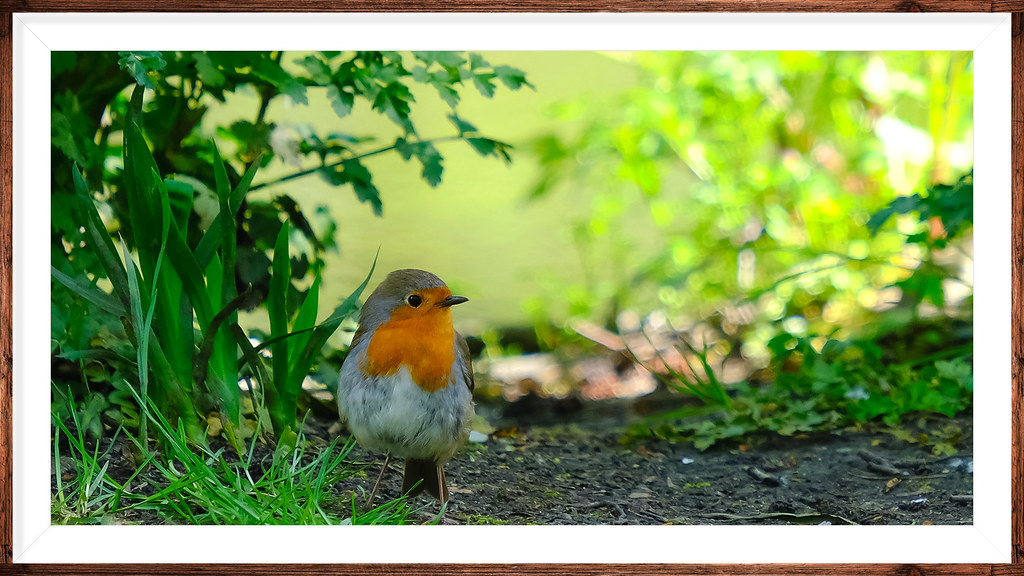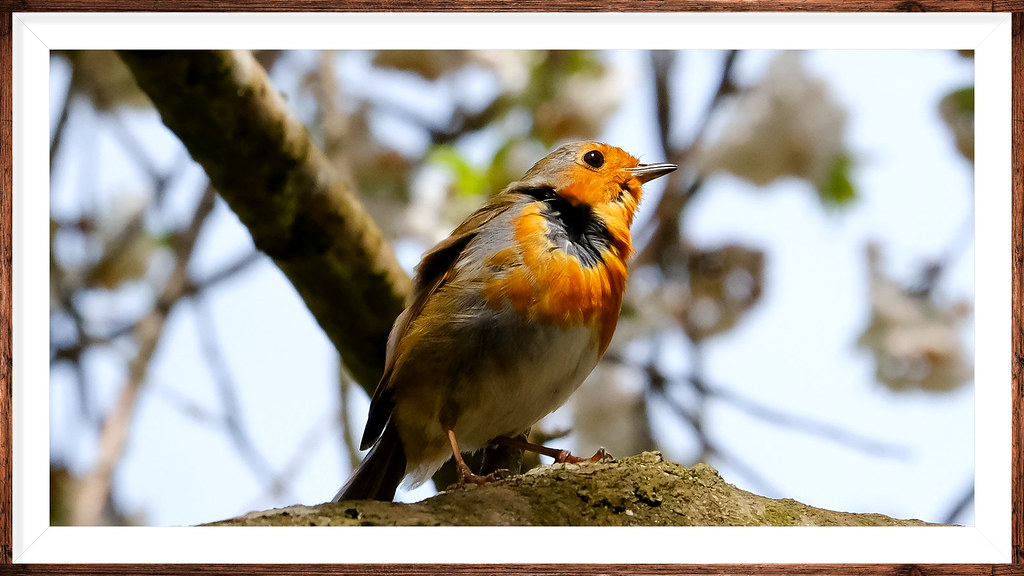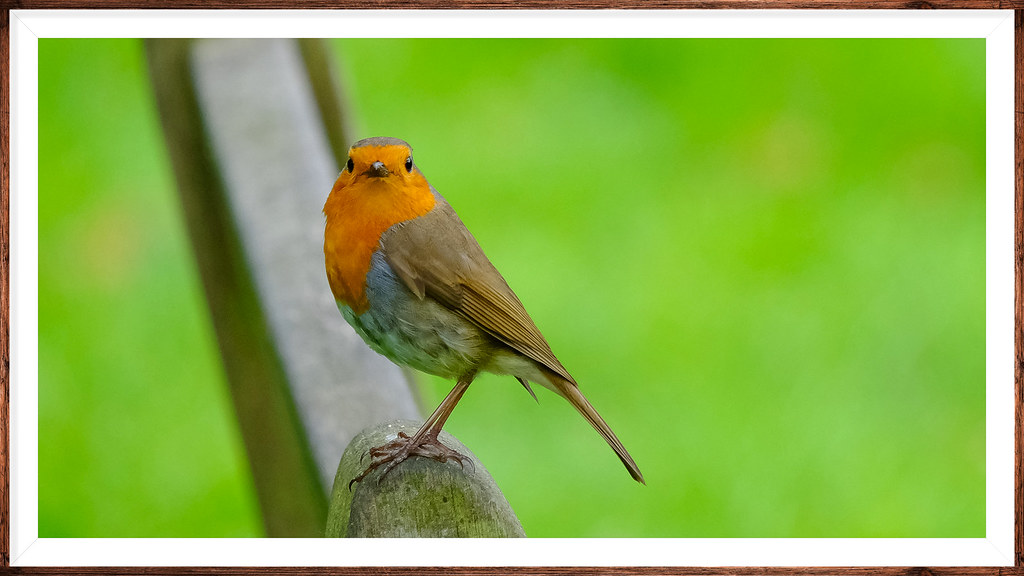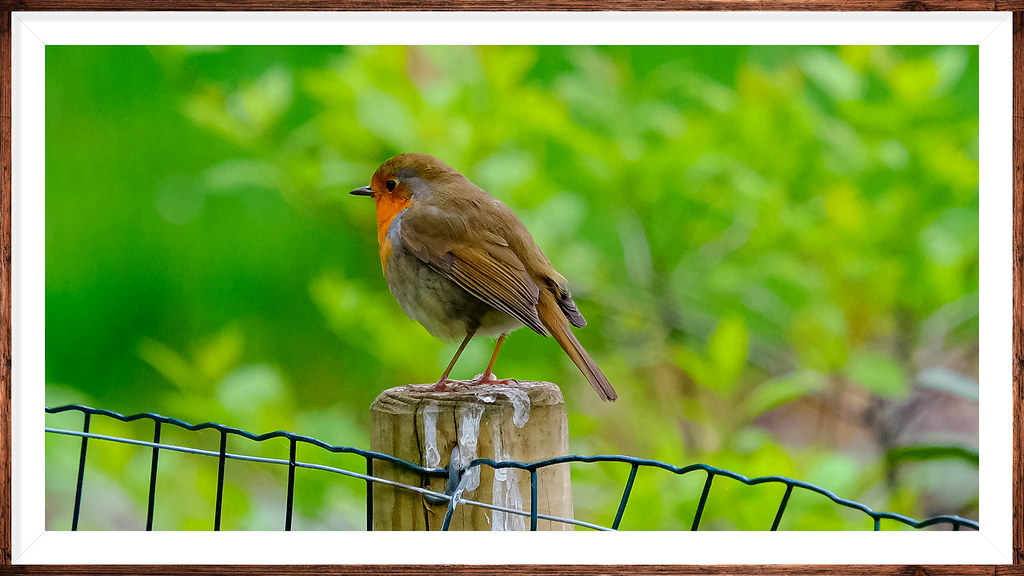#adult robin (Erithacus rubecula)
Video
Erithacus Rubecula...The Robin by Adam Swaine
Via Flickr:
Due to their long legs and somewhat chubby-looking body, they are a beautiful and much-loved bird. But male Robins in particular can be quite mischievous and confrontational during the breeding season and winter months.We find Robins in woodland, hedgerows, parks and gardens. In some riparian forests they can reach settlement densities of up to 20 pairs per 10 ha. Along with the chaffinch, they are one of the most common birds in our forests. The Robin is a so-called "partial migrant", which means some birds decide to spend the winter in warmer places and the rest will stay in the UK all year round
#RSPB#BTO#passerine bird#passerines#perching#woodland#Peckham Rye Park#London#london parks#wildlife#wild#england#english#english birds#britain#british#british birds#uk#Birds#little birds#garden birds#animals#robin#robin red breast#robins#Robin (Erithacus rubecula)#adult robin (Erithacus rubecula)#woodland robins#Adam Swaine#fuji
13 notes
·
View notes
Text
Karoocichla Tilsley & Gaudin, 2023 (new genus)

(An individual of Karoocichla coryphoeus, photographed by Alan Manson, under CC BY-SA 2.0)
Meaning of name: Karoocichla = Karoo thrush [in Greek]
Species included: K. coryphoeus (Karoo scrub robin, type species, previously in Cercotrichas)
Age: Holocene (Meghalayan), extant
Where found: Scrublands of southern Africa
Notes: Karoocichla coryphoeus is an Afro-Eurasian flycatcher, a diverse group of small songbirds. Many Afro-Eurasian flycatchers hunt for insects by flying after them from a perch, though they also include primarily ground-foraging species like the European robin (Erithacus rubecula). The Karoo scrub robin is one of the ground-foraging species.
Most taxonomic authorities currently place the Karoo scrub robin along with other terrestrial, primarily African flycatchers called “scrub robins” in the genus Cercotrichas. However, genetic analyses have found that not all of these scrub robins are each other’s closest relatives. Some scrub robins (including the type species of Cercotrichas, the black scrub robin C. podobe) are more closely related to the magpie robins (genus Copsychus) than to other scrub robins, including the Karoo scrub robin.
This latter group of scrub robins that are not closely related to Cercotrichas proper therefore need to be reclassified into one or more different genera. It was recently suggested that the old genus name Tychaedon could be revived for all members of this group, though it was subsequently pointed out that the even older name Aedonopsis should be used.
Within the Aedonopsis scrub robins, the Karoo scrub robin is the most distant living relative to the other members of this lineage. It additionally exhibits several distinctive traits compared to other species of Aedonopsis, such as hatching with downy feathers (instead of being naked), laying bright turquoise (instead of whitish) eggs, and cooperative breeding behavior in which the adult offspring of a breeding pair may remain with their parents to help care for their younger siblings. As a result, it has been argued that the Karoo scrub robin should be classified into its own unique genus. In fact, the genus Salsolicola was previously proposed for it in 2004. However, the name Salsolicola had already been used for a genus of moths, so the Karoo scrub robin requires a different genus name if it is not considered a member of Aedonopsis. A new paper thus coins the new genus Karoocichla for this bird.
Reference: Tilsley, A. and J. Gaudin. 2023. A replacement name for Salsolicola Oatley, 2004 (Aves: Muscicapidae), preoccupied by Salsolicola Kuznetsov, 1960 (Lepidoptera: Tortricidae). Zootaxa 5271: 196–200. doi: 10.11646/zootaxa.5271.1.14
38 notes
·
View notes
Link
0 notes
Photo

European robin ~ Erithacus rubecula
The European robin is an insectivorous passerine bird that has a large range across Europe, east to Western Siberia and south to North Africa. The bird is almost exclusively sedentary, except in the far north. Relatively small, about 12.5–14.0cm in length, the European robin is a frequent visitor in British gardens and are often observed having little to no fear of humans, especially when doing gardening which gives the birds the opportunity to hunt for earthworms. However, male robins are known for their aggressive behaviour towards other males that stray into their territory and have been observed to even attack their own reflection on occasion. It is estimated that this territorial nature can account for up to 10% of adult robin deaths in some areas.
Robins use a variety of locations for nest building, including crevices, sheltered banks and even man made objects such as upturned brooms, discarded kettle etc. A robin’s nest consists of moss, feathers, small twigs and grass that will see up to three clutches of five to six eggs that will be laid throughout the breeding season. The eggs laid are usually white or cream speckled with a reddish-brown colour. When the chicks fledge they are observed to be a mottled brown colour and have not yet earned their famous orange breast yet.
243 notes
·
View notes
Photo
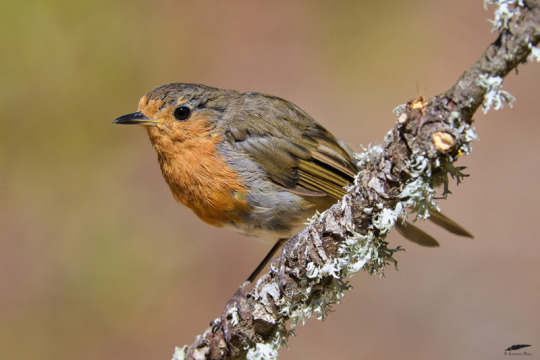
Robin - Pisco-de-peito-ruivo (Erithacus rubecula): adult
Arrábida/Portugal (19/08/2020)
[Nikon D500; AF-S Nikkor 500mm F5,6E PF ED VR with Peak Design Travel Tripod; 1/1600s; F9; 400 ISO]
27 notes
·
View notes
Text

European Robin (Erithacus rubecula) - Stover Country Park, Devon.
The European robin, known simply as the robin or robin redbreast in the British Isles, is a small insectivorous passerine bird, specifically a chat, that was formerly classified as a member of the thrush family but is now considered to be an Old World flycatcher.
Lifespan: 13 months (In captivity)
Clutch size: 5 – 6
Scientific name: Erithacus rubecuula
Wingspan: 20 – 22 cm (Large Adult)
Mass: 16 – 22 g (Large Adult)
#Erithacus rubecula#robin#european robin#birding#birds#bird#wildlife photography#wildlife#nature photography#nature#photographer#original photographers#photography#photographers on tumblr
10 notes
·
View notes
Text
Because it's Christams, I therefore don't really have anything else to do and just got two amazing books about birds, I have decided to write something about birds. I chose this one cause I have a picture of it.
Name:
German name: Rotkehlchen (literally means "red-throat" if you wondered)
Latin name: Erithacus rubecula (rubecula from "ruber" which means red)
English name: Robin redbreast/european robin (probably should have started with that one...)
Order: passerines (Passeriformes)
Suborder: songbirds (passeri)
Family: Flycatchers (Muscicapidae) -> .... and ... belong to those, too
Subfamily: Cossyphinae
Genus: Erithacus
Species: Robin
Characteristics:
Size: 12,5 - 14cm, smaller than sparrow
weight: 10-20g
apperance: Face, throat and chest are orange-red, olive-brown upper side. Delicate, light wing band only recognizable from close up, young brids initially lightly spotted without red. Upright posture and round body.
Life expectancy:
Nestlings: average of 1,25 years
adter 1st year: 3-4 years
oldest known: 17 years and 3 months
Behavior and vocalizations:
little jumps on the ground
food is picked from the ground or from twigs and leaves, often caught with a small jump or leaping forward
almost always solitary animals, all year round claumed revire, in autumn and winter females also occupy territories. Territorial behavior also occurs when resting during the travel.
dispute about territories sttled via singing and presentation of the yellow-red breast
not very fearful in the garden
usually sings in the morning and evening
Sining consists of long, variable stanzas that usually begin with high, pure notes, then lower and fade away
Tones "pearl" and are described as "solemn, wistful or melancholy"
also calls out sharply "zig" in quick succession
Females sing less and shorter than males
Occurrence:
All of europe except of Iceland and the northernmost Finland, the southernmost birds live in nortthwest Africa, in the northern Anatolia and at the southern edge of the Caspisee. In the east, in the east the area extends into eastern Western Siberia. Most birds, however, live in Europe.
Different forest types up to the tree line, in field trees, often also in parks, cemetries and larger gardens rich in shrubbery. Shady and humid locations by water are popular. In winter especially in parks and gardens, occasionally come to feeding places with soft food.
Brooding behavior:
usually brood twice in a row. A change of partner is not uncommon between the broods
Nest in different locations: Soil nests in holes, depressions, under tufts of grass or roots, in breaks and on embankments
higher nests mostly close to the ground, e.g. wall niches, tree holes, piles of wood or in climbing plants
often the old nests of other birds, woodpecker holes or low-hanging nesting boxes are also used
many locations in watering cans, garden sheds or fences are known
the nest consists of moss, dry stalks, padded with finer material on the inside
Both partners feed the young, which usually stay in the nest for 12 to 15 days, but could leave it as early as the 9th day if necessary
After leaving the nest, the still flightless young are still fed and the male imprints them on his song
Fled-out young also beg other bird species up to the size of a blackbird for food, adult robins also feed young of blackbirds, wrens, tits and many others
Migrations
Higher lying and northern brooding areas are completely cleared, but the winter area for those birds begins in southern Scandinavia already and includes central, western and southern Europe.
Outside of the brooding area, robins overwinter in North Africa to the nothern border of the Sahara, from central Asia Minor to northern Egypt and Iran and Iraq.
Resident birds are the robins of Ireland and Great Britain, part migrants most of the ones in Western Europe.
Robins usually migrate at night, the average distance covered per night is 40-90km.
Mythology and cult
Among the ancient Germanic and Celtic tribes of Europe, robins were considered to be the messenger/deliverer of the sun
With the Germanic peoples and the later Swiss there was an association of th ebirds with the red-bearded Thor.
In general, these ethnic groups related many things that resembled fire in colour to the god who ruled this force of nature for the nefeit of humans (robins, redstart, gimoel and goldfinch as symbols of fire and lightning either attract those or protect from them).
Where robins nested as sacred animals of Donar/Thor, people believed that house and farm were under his protection, and the destruction of nests was considered sacrilege, birds near buildings should bring (especially married couples) happiness and peace
In Christ legends, a robin stands by Jesus on the cross, mourns for/with him, and genreally receives the red stain from his blood
In the UK, the birds aren somehow associated with Christmas and were the UK's most popular bird (in the 1960s)
Sources:
"Was fliegt denn da? Der Fotoband", Detlef Singer
"Das BLV Handbuch Vögel, Alle Brutvögel Mitteleuropas", Einhard Bezzel
"Die Vögel Europas und des Mittelmeerraums", Lars Jonsson
Wikipedia
1 note
·
View note
Text
Keith was staying with us for the weekend and so on Saturday, we visited some of our local nature reserves.

Our first stop was at Footscray meadows, a mixture of grassland and woodland along the banks of the river Cray.
One of our first sightings was of a Little Egret fishing in the river, but otherwise, it was fairly quiet – at least as far as wildlife was concerned – Saturday is probably not the best time to visit as it is a favourite place for dog-walkers and families.

We made our way up river towards the five-arch bridge, which forms the head of a lake in the river, where Mallard and Tufted Ducks congregate together with Moorhen, Coot, Mute Swans and Egyptian geese. We also saw a Terrapin basking in the sunlight. These now seem to be a permanent resident of many of our lakes in the area, released by pet owners who no longer want them or who can’t house them when full grown. Walking further upstream from the lake, we heard a couple of Cetti’s warblers calling, but there was little evidence of any small bird migration.
Terrapin (left), Mute Swan (top right) and Egyptian Goose (lower right)
Our next stop was Sutcliffe Park LNR. Here it was evident that the vegetation had grown well this summer as the marsh area was completely covered and impossible to see into. The highlight was a Little Grebe on the Lake.
Our final stop was my home patch around the Tarn. here we found 2 Little Grebes, probably an adult and a juvenile along with a Grey Heron. Keith heard a Grey Wagtail, which winters here each year, but we could not locate it.

Little Grebes – adult (left and top right) and probable juvenile (lower right)
Grey Heron (left) and Coot (right)
Canada Goose [sp] (Branta canadensis)
Mute Swan (Cygnus olor)
Egyptian Goose (Alopochen aegyptiaca)
Mallard [sp] (Anas platyrhynchos)
Tufted Duck (Aythya fuligula)
Little Grebe [sp] (Tachybaptus ruficollis)
Grey Heron [sp] (Ardea cinerea)
Little Egret [sp] (Egretta garzetta)
Common Moorhen [sp] (Gallinula chloropus)
Eurasian Coot [sp] (Fulica atra)
Black-headed Gull (Chroicocephalus ridibundus)
European Herring Gull [sp] (Larus argentatus)
Rock Dove [sp] (Columba livia)
Common Wood Pigeon [sp] (Columba palumbus)
Great Spotted Woodpecker [sp] (Dendrocopos major)
European Green Woodpecker [sp] (Picus viridis)
Rose-ringed Parakeet [sp] (Psittacula krameri)
Eurasian Jay [sp] (Garrulus glandarius)
Eurasian Magpie [sp] (Pica pica)
Carrion Crow [sp] (Corvus corone)
Eurasian Blue Tit [sp] (Cyanistes caeruleus)
Great Tit [sp] (Parus major)
Cetti’s Warbler [sp] (Cettia cetti)
Long-tailed Tit [sp] (Aegithalos caudatus)
Eurasian Blackcap [sp] (Sylvia atricapilla)
Eurasian Wren [sp] (Troglodytes troglodytes)
Common Starling [sp] (Sturnus vulgaris)
Common Blackbird [sp] (Turdus merula)
European Robin [sp] (Erithacus rubecula)
House Sparrow [sp] (Passer domesticus)
Dunnock [sp] (Prunella modularis)
Grey Wagtail [sp] (Motacilla cinerea)
European Goldfinch [sp] (Carduelis carduelis)
Naturelog: 13th October Keith was staying with us for the weekend and so on Saturday, we visited some of our local nature reserves.
0 notes
Text
Robin in Magick
Animals and Witchcraft (The Witches Familiar) Robin Redbreast The European Robin (Erithacus rubecula) is a small, plump, migratory songbird closely related to thrushes. The Robin is affectionately known as “Robin Redbreast” and is undoubtedly one of the best-loved garden birds of Great Britain. His fame is perhaps due to his visible re-appearance at Christmas-time hopping and singing around our gardens where he lives in close proximity to humans. The Robin is Britain’s national bird. After a survey conducted through the pages of The Times in 1960, the Council for Bird Preservation conferred the title “Bird of Britain” on the Robin in 1961. European Robins are widely distributed and can be found in countries all across Europe and as far as central Siberia. They are also found in parts of Asia, North Africa, Turkey and the Azores. The North American Robin (Turdus migratorius) also belongs to the thrush family, but is generally larger and slimmer than its English counterpart, while in Australia and New Guinea there are several other unrelated songbirds also known as Robin. In England, Robins are normally territorial and will stay in the same area throughout their lives, but some are known to migrate short distances and return in winter close to Christmas-time. The European Robin has a grey-brown coat with a distinctive orangey-red throat and chest (hence the familiar name “Robin Redbreast”) trailing down to a white belly and under-tail. They are generally small and plumpish birds growing only to about 12-13cm (5-5½in). Both the male and female have the same coat and colouring, while their young are mottled with greys, browns and buff colours. Robins like to build their nests in sheltered places, such as in hollowed out tree stumps or holes in the ground, into which they use moss, roots, twigs, grass, rags, paper and feathers to form cup-shaped nests. They will also make use of any undisturbed planting pots and other suitable containers found lying about in gardens. During the late winter or early spring, male Robins will seek out their own territories, usually an area of approximately half a hectare, which he defends against all other Robins. Perching himself on the edge of his territory he will declare the area his by singing. Short bursts of singing are followed by short silences, during which he listens for neighbours and potential rivals. If a rival approaches he will sing louder in warning before flying out to challenge the intruder. If they meet and often they do, he’ll puff out his red breast and hop around in a ritual display of threatening behaviour. If that fails to keep the rival away, he will then aggressively attack the intruder, which can result in serious injury and even death. Such attacks account for up to 10% of fatalities in the adult Robin population. Robins have a trilling clear voice and both male and female will sing throughout the year. The male makes use his singing skills to attract females, but at first he will drive them away, and only if she persists will she be accepted. The pair will then form a bond, which is strengthened in courtship by the male feeding the female (or as Shakespeare puts it in his play The Two Gentlemen of Verona: “Win her with gifts if she respect not words”). Robins are generally ground feeding birds, their main food source being flies, insects, spiders and worms, and in winter - berries, soft fruit and seeds. The paired Robins will begin to breed from April to June each year, during which time the female will lay five to six yellowish, light-brown speckled eggs, and incubate them for 14 days before they hatch. Both parents feed their young until they are able to fly, which is normally after 12 to 15 days. The paired Robins will usually produce two broods each year, although occasionally they may even produce a third. Male Robins have an average life expectancy of 1.1 years, which is probably due to their aggressive attacks on rival birds. However, if they can survive past their first year, they can expect to live much longer. One such has been recorded living to the age of 12 years. The Robin's main predator is the domestic cat, which kills 15 times as many Robins as do his other predators, the Sparrowhawk and Owl. Another main cause for such a low life expectancy is severe weather conditions. Low temperatures in winter make the ground very hard, this followed by heavy snow falls can make the Robin's natural foraging for food difficult. In extreme conditions this can lead to fatalities and a significant drop in their population. Scientific classification: The European Robin is classified as: Erithacus rubecula, the American Robin as Turdus migratorius, the Indian Robin as: Saxicoloides fulicata, the Pekin or Chinese Robin as: Leiothrix lutea, the Australian Scarlet Robin as: Petroica multicolour and the African/Asian Magpie Robin Copsychus saularis. The Magpie Robin is also the national bird of Bangladesh. History: The Robin has long been associated with Christmas particularly in Great Britain. During the reign of Queen Victoria (1837-1901) with the introduction of the world’s first unified postage stamp – the famous “Penny Black” in 1840, the Royal Mail postal service in Britain rapidly expanded to include the general public. As a consequence of this reform, there was a steady increase in the public use of the service necessitating the employment of a growing army of letter carriers, thereafter renamed postmen. Initially the postmen were servants of the Crown whose national colour was red, and so the first postmen in Britain wore a bright red liveried uniform, as such they were given a common nickname and became known as “Robin Redbreasts”. At that time and until well into the 20th century, postal deliveries were made 364 days of the year, which included Christmas day, and so the Robin, the Postman and the gifts he brought became associated. Many old Christmas cards depicted Robins delivering the mail. Folklore and Myths: The Robin throughout history has been variously associated with charity, compassion, good luck, bad luck, fire and death; as such he has become a legend in the folklore of many countries. Many stories about the Robin attempt to explain the origin of his red breast, the most common being associated with the birth and death of Christ. One such story relates that when Jesus was crucified on the cross, a Robin flew down and removed a thorn from the crown on his head to relieve some of his suffering. In doing so, the blood of Jesus stained his throat and chest, and ever since his breast has remained red. In a similar story concerning the birth of Christ, a Robin flew into the stables where the baby Jesus was born. Seeing Mary and the boy child sleeping, the Robin noticed a nearby fire had almost gone out, and while fanning the embers back into flame, he burnt and singed his breast feathers. Mary blessed him for his courage, and when his feathers grew back again they remained red in recognition of his efforts. Because of his red breast and this association with fire, like the Raven in mythology, the Robin is said to have brought fire from heaven. As such, in folklore, Robins are considered holy birds, and are beloved by gardeners for they remind him of paradise and the legendary Garden of Eden. A similar myth has it that the Robin was a storm-cloud bird held sacred by Thor, the god of Thunder in Norse mythology. In the old folklore traditions of Great Britain, if a Robin pecks at your window or enters your house, it is likely a death will soon occur there. Likewise, if a Robin flies into a house through an open window, it was taken as a sign of death being present. This idea is thought to have come from an old 16th century folktale called “Babes in the Wood”, which implies that if a Robin finds a human corpse, it would cover the corpse with moss, leaves and flowers, effectively burying it. First published as a ballad by Thomas Millington in Norwich 1595, the “Babes in the Wood” tale has been reworked into many forms: Thus wandered these poor innocents, Till death did end their grief; In one another's arms they died, As wanting due relief; No burial this pretty pair Of any man receives, Till Robin Redbreast piously Did cover them with leaves. This from a 1765 poem by Thomas Percy (1729-1811). It was said to be extremely unlucky to kill a Robin, and the hand that does so will continue to shake thereafter. If a farmer causes the death, he should expect his barn to catch fire or his cow’s milk to flow the colour of blood. It was a common belief in both Britain and Ireland that whatever tragedy befalls the Robin, the person who caused it would suffer the same consequence. If a person destroyed the nest of a Robin, he should expect a death in his family within a year, or a fire to destroy his house, or lightning to strike it and damage it. Breaking the eggs of a Robin will result in something valuable of your own being broken. To see a Robin sheltering in the branches of a tree indicates that rain is on the way, and to see one chirping on an open branch indicates that fine weather is coming. You should make a wish when you see your first Robin of the season, and make sure to do it quick, for if the bird flies away beforehand, you’ll receive no good luck for the next twelve months. Another association of the Robin with death is in a pagan belief. In Celtic traditions, Yule is the time when the Oak King triumphs over the Holly King. The Holly King represents the death and darkness that has ruled since the onset of Samhain (Halloween). At the time of the Winter Solstice, the Oak King is reborn and begins a new cycle of life and lightness. A similar version of the Oak King versus the Holly King theme is the killing of the Wren. The Wren is the little King of the Waning Year, and is killed by the Robin Redbreast, the new King of the Waxing Year. Sources: Penguin Hutchinson Reference Library Copyright (c) 1996 Helicon Publishing and Penguin Books Ltd Microsoft ® Encarta ® 2006. © 1993-2005 Microsoft Corporation. All rights reserved. Encyclopædia Britannica 2005 Ultimate Reference Suite DVD. Copyright © 1994-2003 Encyclopedia Mythica: http://www.pantheon.org/articles/g/goblin.html http://www.birdguides.com/species/species.asp?sp=130019 Plus too many more to mention.
3 notes
·
View notes
Photo

•| European robin, Erithacus rubecula: Mystery bird. This is the name I finally found after some research on the internet. The 'mystery' part; I'm not sure why! Anyway I'm excited that I got to click this one here in Kuwait (Fintas park). Those interested can read further. Bird experts can correct me if I'm wrong😁 |• **************************** •| Reference: https://www.theguardian.com/science/grrlscientist/2012/jul/27/9. This is an adult European robin, Erithacus rubecula, a small passerine that was recently removed from Turdidae, the thrush family, into Muscicapidae, the Old World flycatcher family. Currently, there are three species in the genus, Erithacus, but this will likely change soon. Thanks to convergent evolution, the Japanese robin, E. akahige, and the Ryūkyū robin, E. komadori, are currently placed in Erithacus, but recent research suggests they should be removed, leaving the European robin as the sole species in this genus. Robins are mainly insectivorous birds that range widely over most of western Eurasia. They will also consume fruits and berries as well as seeds in winter. Some populations are migratory, whilst others are territorial residents (as in the British Isles). Robins construct a cup nest in a sheltered place, and are noted for some of the unusual and amusing nest site choices they make. For example, nests have been found on machinery, in flower pots and even on hats.|• . . •| #birdsofkuwait |• . . #photo_pond #birdsofinstagram . . . •|P o s t 590 | A p r 21, 2018|• . . #birdsofinstagram #birdphotography #streetphotographyindia #indianphotography #Birds #skybrilliance #indianshutterbugs #sourceadventures #sunset #kuwait #birdy #itz_mumbai #birding #everydaymumbai #dslrofficial #canon #canonphotography #birdofparadise #india_undiscovered #nvedi #hirenkhambhayta #bird_brilliance #birds_bees_flowers_n_trees #indianphotographyclub (at Fintas Park)
#sunset#birdphotography#canonphotography#hirenkhambhayta#birdsofkuwait#canon#indianphotographyclub#sourceadventures#birds_bees_flowers_n_trees#indianphotography#birdsofinstagram#birdy#photo_pond#kuwait#birds#everydaymumbai#indianshutterbugs#dslrofficial#birding#streetphotographyindia#bird_brilliance#india_undiscovered#itz_mumbai#skybrilliance#birdofparadise#nvedi
0 notes
Video
Robin on the Spring Lichen by Adam Swaine
Via Flickr:
The European robin, known simply as the robin or robin redbreast in Great Britain and Ireland, is a small insectivorous passerine bird that belongs to the chat subfamily of the Old World flycatcher family.
#lichen#lichens#passerine bird#passerines#perching#woodland#RSPB#BTO#robin#robin red breast#robins#Robin (Erithacus rubecula)#adult robin (Erithacus rubecula)#woodland robins#Birds#little birds#garden birds#england#english#english birds#britain#british#british birds#nature lovers#nature#natures finest#nature watcher#wildlife#wild#animals
15 notes
·
View notes
Video
Little Robin @ Woods Mill Sussex Reserve by Adam Swaine
Via Flickr:
Beautiful spring sunlight at the nature reserve on the South Downs capturing this lovely robin by the pond..
#woods Mill#nature lovers#nature#natures finest#nature watcher#nature reserve#sussex#West Sussex#BTO#RSPB#(Old World flycatchers)#passerine bird#passerines#england#english#english birds#Birds#Bird#britain#british#british birds#little birds#garden birds#wildlife#spring#robin#robin red breast#robins#adult robin (Erithacus rubecula)#(European) Robin
9 notes
·
View notes
Video
Churchyard Robin @ Edenbridge Kent.. by Adam Swaine
Via Flickr:
The European robin, known simply as the robin or robin redbreast in Great Britain and Ireland, is a small insectivorous passerine bird that belongs to the chat subfamily of the Old World flycatcher family.
#robin#robin red breast#robins#Robin (Erithacus rubecula)#adult robin (Erithacus rubecula)#woodland robins#(European) Robin#churchyard#Edenbridge village#passerine bird#passerines#(Old World flycatchers)#perching#spring#spring in kent#spring blossom#nature watcher#natures finest#nature#nature lovers#Kent#kentish villages#Birds#Bird#garden birds#little birds#england#english#english birds#english villages
10 notes
·
View notes
Video
OLD WORLD FLYCATCHER (MUSCICAPIDAE) Robins by Adam Swaine
Via Flickr:
The flycatchers in the genus Ficedula are typically small with slender bodies and rounded heads. In many cases they are sexually dimorphic in their plumage, with the males being brightly or strikingly coloured and the females being duller or drabber.CHATS AND ALLIES (SUBFAMILY SAXICOLONAE) ROBIN (GENUS ERITHACUS) The robins are small passerine birds comprising the genus Erithacus. They were formerly classed as members of the thrush family, but now considered to be Old World flycatchers of the chat subfamily (Saxicolinae).
#RSPB#BTO#Peckham Rye Park#perching#passerines#passerine bird#wildlife#wild#spring#Birds#Bird#little birds#garden birds#nature lovers#nature#natures finest#nature watcher#London#london parks#robin#robin red breast#robins#Robin (Erithacus rubecula)#adult robin (Erithacus rubecula)#(European) Robin#animals#england#english#english birds#britain
5 notes
·
View notes
Video
Spring Robin @ Peckham rye Park London by Adam Swaine
Via Flickr:
Lovely light and beautiful bird and a quick walk around the park this morning..
#RSPB#BTO#(Old World flycatchers)#passerine bird#passerines#perching#uk#nature lovers#nature#natures finest#nature reserve#england#english#english birds#britain#british#british birds#robin#robin red breast#robins#Robin (Erithacus rubecula)#adult robin (Erithacus rubecula)#woodland robins#Adam Swaine#2024#fuji#wildlife#wild#seasons#spring
2 notes
·
View notes
Video
Little Robin in the Spring Sun..London by Adam Swaine
Via Flickr:
This lovely family of 4 live in the wildlife garden in peckham rye park.
#RSPB#BTO#perching#passerine bird#passerines#sunlight#spring#Peckham Rye Park#london parks#nature lovers#nature#natures finest#nature watcher#uk#South East#SE22#beautiful#robin#robin red breast#robins#Robin (Erithacus rubecula)#adult robin (Erithacus rubecula)#woodland robins#Birds#little birds#garden birds#Parks#woodland#seasons#animals
3 notes
·
View notes


